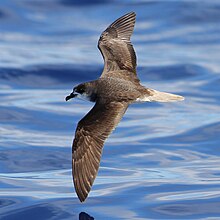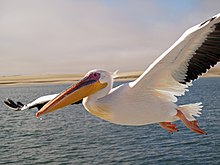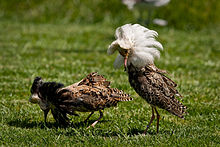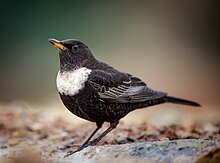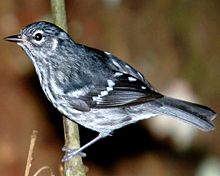Our website is made possible by displaying online advertisements to our visitors.
Please consider supporting us by disabling your ad blocker.
Portal:Birds
The Birds Portal

Birds are a group of warm-blooded vertebrates constituting the class Aves (Latin: [ˈaveːs]), characterised by feathers, toothless beaked jaws, the laying of hard-shelled eggs, a high metabolic rate, a four-chambered heart, and a strong yet lightweight skeleton. Birds live worldwide and range in size from the 5.5 cm (2.2 in) bee hummingbird to the 2.8 m (9 ft 2 in) common ostrich. There are over 11,000 living species and they are split into 44 orders. More than half are passerine or "perching" birds. Birds have wings whose development varies according to species; the only known groups without wings are the extinct moa and elephant birds. Wings, which are modified forelimbs, gave birds the ability to fly, although further evolution has led to the loss of flight in some birds, including ratites, penguins, and diverse endemic island species. The digestive and respiratory systems of birds are also uniquely adapted for flight. Some bird species of aquatic environments, particularly seabirds and some waterbirds, have further evolved for swimming. The study of birds is called ornithology.
Birds are feathered theropod dinosaurs and constitute the only known living dinosaurs. Likewise, birds are considered reptiles in the modern cladistic sense of the term, and their closest living relatives are the crocodilians. Birds are descendants of the primitive avialans (whose members include Archaeopteryx) which first appeared during the Late Jurassic. According to some estimates, modern birds (Neornithes) evolved in the Late Cretaceous or between the Early and Late Cretaceous (100 Ma) and diversified dramatically around the time of the Cretaceous–Paleogene extinction event 66 million years ago, which killed off the pterosaurs and all non-ornithuran dinosaurs.
Many social species preserve knowledge across generations (culture). Birds are social, communicating with visual signals, calls, and songs, and participating in such behaviour as cooperative breeding and hunting, flocking, and mobbing of predators. The vast majority of bird species are socially (but not necessarily sexually) monogamous, usually for one breeding season at a time, sometimes for years, and rarely for life. Other species have breeding systems that are polygynous (one male with many females) or, rarely, polyandrous (one female with many males). Birds produce offspring by laying eggs which are fertilised through sexual reproduction. They are usually laid in a nest and incubated by the parents. Most birds have an extended period of parental care after hatching.
Many species of birds are economically important as food for human consumption and raw material in manufacturing, with domesticated and undomesticated birds being important sources of eggs, meat, and feathers. Songbirds, parrots, and other species are popular as pets. Guano (bird excrement) is harvested for use as a fertiliser. Birds figure throughout human culture. About 120 to 130 species have become extinct due to human activity since the 17th century, and hundreds more before then. Human activity threatens about 1,200 bird species with extinction, though efforts are underway to protect them. Recreational birdwatching is an important part of the ecotourism industry. (Full article...)
Featured articles
Selected general bird topic

Sexual selection in birds concerns how birds have evolved a variety of mating behaviors, with the peacock tail being perhaps the most famous example of sexual selection and the Fisherian runaway. Commonly occurring sexual dimorphisms such as size and color differences are energetically costly attributes that signal competitive breeding situations. Many types of avian sexual selection have been identified; intersexual selection, also known as female choice; and intrasexual competition, where individuals of the more abundant sex compete with each other for the privilege to mate. Sexually selected traits often evolve to become more pronounced in competitive breeding situations until the trait begins to limit the individual's fitness. Conflicts between an individual fitness and signaling adaptations ensure that sexually selected ornaments such as plumage coloration and courtship behavior are "honest" traits. Signals must be costly to ensure that only good-quality individuals can present these exaggerated sexual ornaments and behaviors.
Bird species often demonstrate intersexual selection, perhaps because – due to their lightweight body structures – fights between males may be ineffective or impractical. Therefore, male birds commonly use the following methods to try to seduce the females:
- Colour: Some species have ornate, diverse, and often colourful feathers.
- Song: Male birdsong provides an important way of protecting territory (intrasexual selection).
- Nest construction: In some species, males build nests that females subject to rigorous inspection, choosing the male that makes the most attractive nest.
- Dance: Males dance in front of females. Cranes provide a well-known example. (Full article...)
Selected taxon
Tinamous (/ˈtɪnəmuːz/) are members of the order Tinamiformes (/ˌtɪnəməˈfɔːrmiːz/), and family Tinamidae (/təˈnæmədiː/), divided into two distinct subfamilies, containing 46 species found in Mexico, Central America, and South America. The word "tinamou" comes from the Galibi term for these birds, tinamu. Tinamous are the only living group of palaeognaths able to fly, and were traditionally regarded as the sister group of the flightless ratites, but recent work places them well within the ratite radiation as most closely related to the extinct moa of New Zealand, implying flightlessness emerged among ratites multiple times. Tinamous first appear in the fossil record in the Miocene epoch. They are generally sedentary, ground-dwelling and, though not flightless, when possible avoid flight in favour of hiding or running away from danger. They are found in a variety of habitats, ranging from semi-arid alpine grasslands to tropical rainforests. The two subfamilies are broadly divided by habitat, with the Nothurinae referred to as steppe or open country tinamous, and the Tinaminae known as forest tinamous.
Although some species are quite common, tinamous are shy and secretive birds. They are active during the day, retiring to roosts at night. They generally have cryptic plumage, with males and females similar in appearance, though the females are usually larger. They are opportunistic and omnivorous feeders, consuming a wide variety of plant and animal food from fruits and seeds to worms, insects and small vertebrates. They will dust-bathe as well as wash themselves by standing in heavy rain. They are heard more often than seen, communicating with each other by a variety of frequently given, characteristic calls, especially during the breeding season.
With occasional exceptions, a male tinamou maintains a territory and a nesting site during the breeding season which a succession of females will visit, laying their eggs in the same nest. Females will wander through several territories mating with, and laying eggs in the nests of, the resident males. Nests are always on the ground, concealed in vegetation or among rocks. Eggs are relatively large and glossy, often brightly colored when laid, and are incubated by the males for a period of two to three weeks. The chicks can run soon after hatching and are largely self-sufficient at three weeks old. (Full article...)
Topics
Anatomy: Anatomy • Skeleton • Flight • Eggs • Feathers • Plumage
Evolution and extinction: Evolution • Archaeopteryx • Hybridisation • Late Quaternary prehistoric birds • Fossils • Taxonomy • Extinction
Behaviour: Singing • Intelligence • Migration • Reproduction • Nesting • Incubation • Brood parasites
Bird orders: Struthioniformes • Tinamiformes • Anseriformes • Accipitriformes • Galliformes • Gaviiformes • Podicipediformes • Procellariiformes • Sphenisciformes • Pelecaniformes • Ciconiiformes • Phoenicopteriformes • Falconiformes • Gruiformes • Charadriiformes • Pteroclidiformes • Columbiformes • Psittaciformes • Cuculiformes • Strigiformes • Caprimulgiformes • Apodiformes • Coraciiformes • Piciformes • Trogoniformes • Coliiformes • Passeriformes
Bird lists: Families and orders • Lists by region
Birds and humans: Ringing • Ornithology • Bird collections • Birdwatching • Birdfeeding • Conservation • Aviculture
Quotes
| “ | Have you ever observed a humming-bird moving about in an aerial dance among the flowers - a living prismatic gem.... it is a creature of such fairy-like loveliness as to mock all description. | ” |
Resources
Free online resources:
- SORA: The Searchable Online Research Archive (SORA) has decades worth of archives of the following journals: The Auk, The Condor, Journal of Field Ornithology, North American Bird Bander, Studies in Avian Biology, Pacific Coast Avifauna, and The Wilson Bulletin. Coverage ends around 2000. The ability to search all journals or browse exists on the front page.
- Notornis: The Journal of the Ornithological Society of New Zealand covers New Zealand and the South Pacific.
- New Zealand Journal of Ecology: This journal often publishes bird-related articles. Like Notornis, this journal is concerned with New Zealand and surrounding areas.
- Marine Ornithology: Published by the numerous seabird research groups, Marine Ornithology is specific and goes back many years.
- BirdLife International: The Data Zone has species accounts for every species, although threatened species and some key groups have greater detail with others only having status and evaluation.
- Author Index: This is a good source for binomial authorities for taxoboxes.
There is also Birds of North America, Cornell University's massive project collecting information on every breeding bird in the ABA area. It is available for US$40 a year.
For more sources, including printed sources, see WikiProject Birds.
WikiProjects
Selected images
Selected bird anatomy topic

The uncinate processes of the ribs are extensions of bone that project caudally from the vertical segment of each rib. (Uncinate means hooked from Latin uncinatus, from uncinus, barb, from uncus, hook.) They are found in birds (except for screamers), reptiles, and the early amphibian Ichthyostega.
These processes can serve to attach scapula muscles, and help to strengthen the rib cage overlapping with the rib behind them. They are also shown to have a role in respiration by increasing the effectiveness of muscles involved in inspiration including the appendicocostal muscles. The processes are short in walking birds and long in diving species and are of intermediate length in non-specialist birds. The screamers (Anhimidae) are unique in lacking this process. The process has also been noted in some enantiornitheans. Although among living vertebrates, bony uncinate processes are unique to birds, cartilaginous uncinate processes are present in crocodiles. The uncinate process has also been reported in Sphenodon and fossil vertebrates including Caudipteryx, oviraptorids, dromaeosaurids, Confuciusornis, Chaoyangia, and Longipteryx; however it apparently does not occur in Archaeopteryx, though Codd et al. (2007) reported uncinate processes in Archaeopteryx. (Full article...)
Selected species
The species was on the brink of extirpation in the contiguous United States (while flourishing in much of Alaska and Canada) late in the 20th century, but now has a stable population and has been officially removed from the U.S. federal government's list of endangered species. The bald eagle was officially reclassified from "endangered" to "threatened" on July 12, 1995 by the U.S. Fish & Wildlife Service. On July 6, 1999, a proposal was initiated "To Remove the Bald Eagle in the Lower 48 States From the List of Endangered and Threatened Wildlife."
Did you know
- ...that the blue-throated piping-guan is a South American bird similar to a turkey?
- ...that despite only being eight inches tall, the tiny hawk, a raptor found throughout much of the central Neotropics, successfully hunts hummingbirds?
- ...that the blue-faced honeyeater of eastern and northern Australia is also known as the "bananabird" for its fondness for that fruit?
Categories
Related portals
Things you can do
Create requested articles (WikiProject Birds – Article requests):
Do these tasks:
 |
Here are some tasks awaiting attention:
|
More outstanding tasks at the project's cleanup listing, Category:Birds articles needing attention, and Wikipedia:WikiProject Birds/Todo.
Taxonomy of Aves
| Class Aves, divided into superorders, orders, suborders (where indicated), and families. | ||||
|---|---|---|---|---|
|
Associated Wikimedia
The following Wikimedia Foundation sister projects provide more on this subject:
-
Commons
Free media repository -
Wikibooks
Free textbooks and manuals -
Wikidata
Free knowledge base -
Wikinews
Free-content news -
Wikiquote
Collection of quotations -
Wikisource
Free-content library -
Wikispecies
Directory of species -
Wikiversity
Free learning tools -
Wikivoyage
Free travel guide -
Wiktionary
Dictionary and thesaurus
Sources
- ^ Hudson, William Henry (1998). Green Mansions. Oxford, UK: Oxford University Press. p. 63. ISBN 0-19-283-288-3.
Previous Page Next Page


